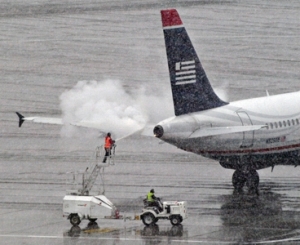Dec 23 2010
The buildup of ice on surfaces can cause problems in many situations: On airplane wings or on their engine turbine blades, ice can both add weight and interfere with a wing’s lift, which can make it impossible to take off; on high-voltage electrical lines, the weight of ice can cause lines to snap, causing blackouts and endangering people nearby; and on structures such as oil-drilling rigs, it can make even basic operations treacherous for people trying to work on slippery surfaces.
Preventing these icy buildups usually means using deicing materials (salt or glycol), sprinkled or sprayed on a surface, or activating heating coils embedded in the surface material.
Deicing chemicals can be toxic, and require constant application, and heating coils waste energy, so researchers have been looking for better ways of handling the problem, ideally through a passive method — one based on chemical or physical properties of the surface, and requiring no ongoing input of energy or work. But one such proposed solution — the use of a super-hydrophobic (water-repellent) coating — has been shown by new research from MIT and a team at General Electric to have serious problems.
 Present methods of preventing ice buildup on planes rely primarily on deicing solutions that are sprayed onto the wings and tail.
Present methods of preventing ice buildup on planes rely primarily on deicing solutions that are sprayed onto the wings and tail.
The reason such a coating would not work has to do with frost — ice that forms on a surface directly from a vapor state, or by freezing of condensed droplets. The formation of frost, according to a study published this month in Applied Physics Letters, could completely defeat the water-repelling properties of a surface that normally would inhibit ice buildup — and, in fact, could actually promote ice formation. But the study also suggests that a more complicated, patterned surface might still work.
It has been “a big open question” whether the super-hydrophobic behavior of certain surfaces would extend to preventing the buildup of ice on those surfaces, says Kripa Varanasi, the d'Arbeloff assistant professor of mechanical engineering. In the APL paper, however, Varanasi and his student J. David Smith, along with Tao Deng and colleagues at GE Research, report that when super-hydrophobic surfaces are exposed to supersaturated air (such as found in clouds), frost readily forms — thus defeating the purpose of the coating. “If frost forms, it actually aggravates the problem,” Varanasi says, because it provides a kind of foundation on which ice quickly can build up to form a thick layer. “We need to be able to control this first phase, when ice nucleation occurs,” he says, referring to the initial formation of ice crystals that, once begun, grows quickly.
Super-hydrophobic coatings cause water to bead up into droplets instead of spreading out across a surface. Many researchers had assumed that the coatings would also prevent ice from forming or adhering to the surface. But in his study, using an environmental scanning electron microscope to study the process, Varanasi and his team found there’s a limit to how much the coatings could prevent ice from beginning to stick to a smooth surface.
But this research, in which they looked not just at how ice and frost form in a stationary situation but also at what happens when the water droplets are moving rapidly before they strike the surface, has pointed to a possible solution. It turns out that certain kinds of complex nano-scale texturing of the surface can drastically improve the hydrophobic qualities, even on a moving surface, by preventing the forming droplets from finding a suitable flat surface to stick to. “We have to go another way, we have to do textures,” he says, adding that getting the size and configuration of these textures exactly right will be the subject of future research.
Finding the kinds of patterns that can prevent ice nucleation on surfaces is just the first step, Varanasi says. In order to be a practical solution for the many applications where ice buildup is a problem, the patterning has to be something that can be manufactured on large surfaces at reasonable cost. “That will be the real breakthrough,” Varanasi says, when someone finds a way to produce “scalable manufacturing techniques, with material that can survive in these kinds of applications.”
Neelesh Patankar, associate professor of mechanical engineering at Northwestern University, says this work “is significant because it shows clearly that frost formation imposes severe constraints on the development of textured icephobic surfaces. This was not previously known.” The fact that Varanasi and his team showed that textures of a certain scale (micron-sized patterns) would not work, Patankar says, is “an important result in the field since it possibly tells us where not to look.”
Patankar adds that “The question for the future is: what are the right parameters, specifically, the roughness scale that could lead to icephobic surfaces even in the presence of frost formation?” That is a question that Varanasi and other researchers will now need to explore.
Source: http://web.mit.edu/